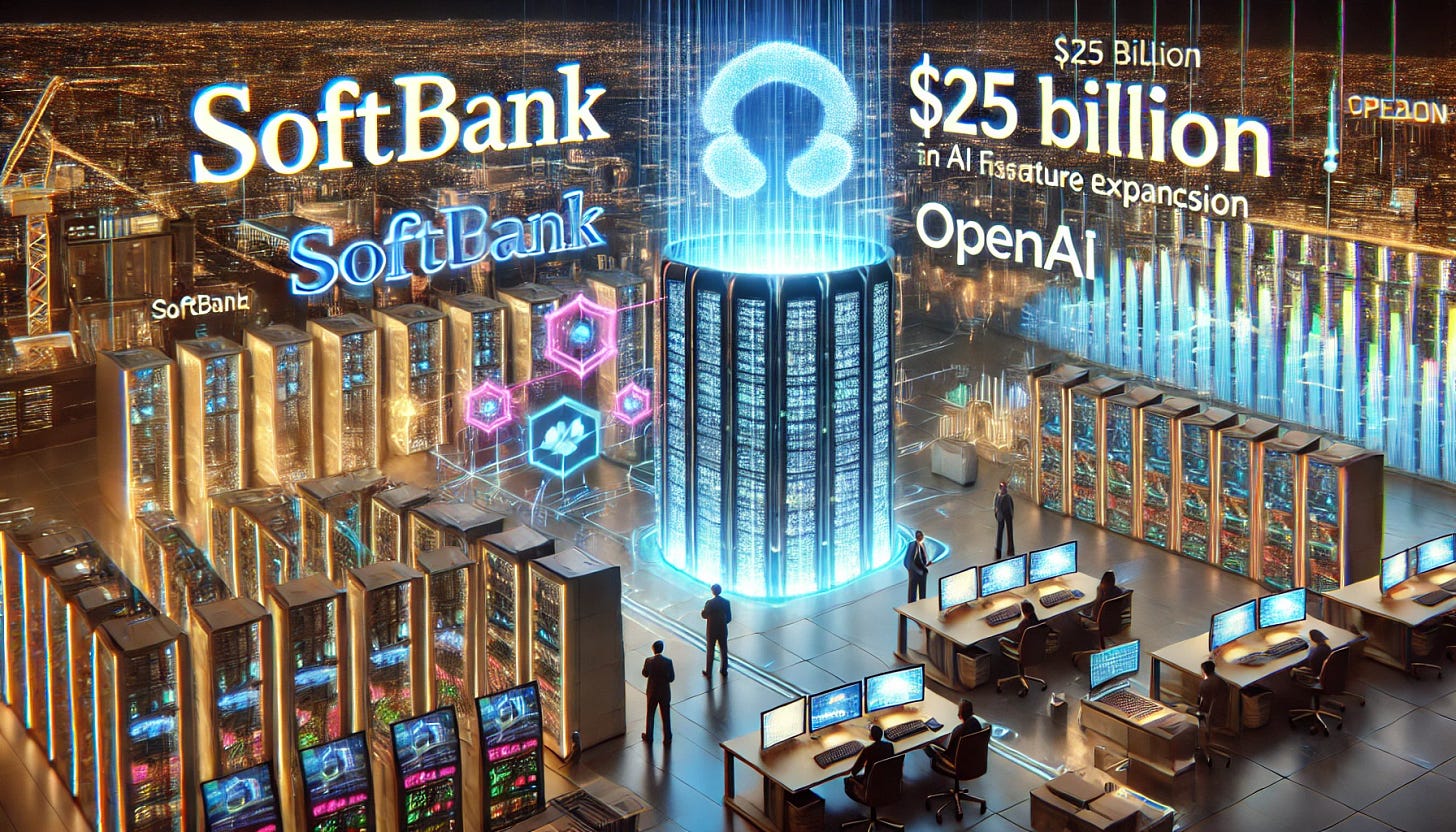🚀 Microsoft Azure AI-Powered Earnings Surge
Welcome, AI & Semiconductor Investors,
Microsoft’s latest earnings soared beyond all expectations, fueled by a booming AI business now topping $13B in annual revenue.
We’ll also dig into SoftBank’s colossal $25B bet on OpenAI and how Meta’s AI glasses and billion-person assistants could reshape the future of tech—stay tuned!
What The Chip Happened?
🚀 Microsoft Azure AI-Powered Earnings Surge
🔥 SoftBank’s Mega AI Bet with OpenAI
🕶️ Meta’s AI Glasses and Billion-Person Assistants
Read time: 7 minutes
Microsoft (NASDAQ: MSFT)
🚀 Microsoft Azure AI-Powered Earnings Surge
What The Chip: Microsoft just reported strong Q2 FY25 results, beating Wall Street expectations on both revenue and EPS. The company highlighted surging demand for AI-driven solutions in both the commercial and consumer markets, with its AI business now surpassing an annual revenue run rate of $13 billion.
Details:
🤖 AI Boom: CEO Satya Nadella noted, “Our AI business has surpassed an annual revenue run rate of $13 billion, up 175% year-over-year.” Azure AI services grew 157%.
📈 Cloud Momentum: Overall Microsoft Cloud revenue reached $40.9 billion, up 21% from last year. CFO Amy Hood emphasized they remain committed to “balancing operational discipline with continued investments” in cloud and AI.
💻 Productivity Suite Growth: Microsoft 365 Commercial seats grew 7%, while Copilot adoption remains strong. Notably, “the majority of existing enterprise customers come back to purchase more seats,” per Nadella.
🎮 Gaming Mix: Gaming revenue dipped 7% year-over-year, but strong new titles like Call of Duty boosted Xbox content and services revenue by 2%.
🔎 Search & Ads: Bing and Edge continued to gain market share, pushing search and news advertising revenue (excluding traffic acquisition costs) up 21%.
🖥️ Windows & Devices: Windows OEM revenue inched up 4%, partly due to “commercial inventory builds in advance of Windows 10 end support,” according to Hood.
📊 Financial Highlights: Earnings per share were $3.23 (versus $3.11 expected), and revenue came in at $69.63 billion (versus $68.78 billion expected).
Why AI/Semiconductor Investors Should Care: With Microsoft doubling down on data center expansions and GPU/AI infrastructure, demand for advanced chips remains robust. Their success in deploying large-scale AI workloads underscores the potential for chipmakers and AI service providers in this market. Yet, careful inventory management and cost considerations for new AI deployments will be key factors to watch, making MSFT’s momentum a bellwether for the broader semiconductor and AI ecosystem.
Moore Semiconductor Investing
📗 [NEW!!] Unlock Q4 Semiconductor Earnings --- 60% OFF (NEW EARNINGS)
What The Chip: Get a front-row seat to the financials shaping the semiconductor industry. This continuously updated e-book by Jose Najarro distills the latest Q4 quarterly insights—from wafer production trends to AI chip breakthroughs—into a single comprehensive resource.
Details:
🔵 Dynamic Updates: Start with giants like TSMC and ASML, then expand to 30+ companies as their Q4 2024 earnings roll in. Earnings are restarting!!
🔵 Broad Coverage: From traditional chipmakers to cutting-edge AI semiconductor players, get the full picture as it emerges.
Why AI/Semiconductor Investors Should Care: This evolving earnings handbook gives you a strategic edge. Understanding quarterly earnings data is crucial for gauging industry health, discovering new growth leaders, and aligning your investment approach with emerging technological waves.
Disclaimer: For educational and informational purposes only. Not financial advice. Consult with a qualified professional before making any investment decisions. Updates are only for the Quarter of Earnings.
SoftBank (9984.T)
🔥 SoftBank’s Mega AI Bet with OpenAI
What The Chip: SoftBank is reportedly in advanced talks to invest a massive $25 billion in OpenAI, overshadowing Microsoft’s initial stake in the ChatGPT maker. This monumental deal could see SoftBank’s total AI spending with OpenAI surpass $40 billion, factoring in joint ventures like the Stargate data center project.
Details:
🚀 Massive Cash Infusion: SoftBank’s potential $25 billion direct investment could make it OpenAI’s largest single backer, eclipsing Microsoft’s earlier stake.
🏗 Stargate Commitment: Both SoftBank and OpenAI are already set to invest $100 billion in Stargate, a U.S. data center project, with the possibility of expanding to $500 billion over four years. Around 20% of Stargate’s funding will be equity-based, while the rest relies on debt secured against assets and cash flow.
🌐 Reduced Reliance on Microsoft: By bringing SoftBank on board, OpenAI aims to decrease its dependence on Microsoft’s cloud infrastructure. This shift comes after Microsoft agreed to give up its exclusivity as OpenAI’s cloud provider.
🥊 DeepSeek Distillation Feud: Chinese firm DeepSeek’s R1 “reasoning” model rattled markets by achieving results with fewer resources. OpenAI alleges DeepSeek used its proprietary models via “distillation,” potentially violating OpenAI’s terms of service.
💸 Nvidia Woes: Amid fears that cheaper AI development could dampen the need for high-end GPU spending, Nvidia’s market value dropped by up to $589 billion in a single day before making a slight recovery.
🗣 Masayoshi Son’s Biggest Play Since WeWork: After pouring $16 billion into WeWork, SoftBank founder Masayoshi Son is ready for another huge gamble. In reference to the AI push, he was quoted in Financial Times saying, “We are excited to push the envelope on generative AI.”
⚖ OpenAI’s New For-Profit Path: OpenAI, once a nonprofit, is negotiating to become a for-profit entity. Its $157 billion valuation underscores the massive potential investors see in AI-driven applications.
Why AI/Semiconductor Investors Should Care: These sizeable investments hint at continued demand for AI infrastructure, benefiting data center operators and chipmakers—though competition from more cost-efficient AI models could stir market volatility. With SoftBank and OpenAI forging new partnerships, technology investors should track how reduced dependency on a single cloud provider and emerging “distilled” models might reshape the AI hardware landscape.
Meta (NASDAQ: META)
🕶️ Meta’s AI Glasses and Billion-Person Assistants
What The Chip: Meta just reported strong Q4 2024 results, beating analyst estimates on both EPS and revenue. CEO Mark Zuckerberg emphasized major strides in AI, personalized assistants, and smart glasses adoption—and signaled 2025 could be even bigger for these efforts.
Details:
🔎 Blowout Earnings: Meta crushed expectations with EPS of $8.02 versus the $6.77 projected, on revenues of $48.39 billion—above the anticipated $47.04 billion. CFO Susan Li called it “strong business performance” driven by better monetization and steady advertiser demand.
🤖 AI Everywhere: Mark Zuckerberg highlighted Meta AI’s explosive growth to “hundreds of millions” of users across Facebook, Instagram, and especially WhatsApp. “We believe that people don’t all want to use the same AI,” he said, explaining Meta’s push for highly personalized AI models.
📱 Llama 4 in the Works: Zuckerberg mentioned Llama 4—a multimodal “omni model” aimed at open-source leadership. “I think this will be the year Llama and open-source become the most advanced and widely used AI models,” he stated.
🕶️ Smart Glasses Traction: Ray-Ban Meta AI glasses are a “real hit,” according to Zuckerberg. He emphasized 2025 as pivotal: “This will be a defining year that determines if we’re on a path toward many hundreds of millions of AI glasses users…or if it’s going to be a longer grind.”
💾 Heavy Capex Investments: Susan Li forecasted $60–65 billion in 2025 CapEx, with “the majority…directed towards our core business.” She noted, “We expect that we are continuing to purchase third-party silicon from leading providers, but we’re also very invested in developing our own custom silicon.”
⚖️ Regulatory & Legal Landscape: Meta cited uncertainties in both the U.S. and EU. While Zuckerberg sees a more supportive U.S. administration, he remains vigilant over ongoing regulatory headwinds.
🤑 Monetization Goals: Despite a focus on building “highly intelligent, personalized AI assistants” first, monetization avenues (ads, premium features) loom large. “Our initial focus for Meta AI is building a great consumer experience,” said Li, but expect revenue models to follow once user scale is reached.
Why AI/Semiconductor Investors Should Care: Meta’s massive infrastructure spending hints at long-term AI leadership ambitions, a positive sign for chip demand (both established GPU players and custom silicon). If Meta’s AI glasses and assistants gain traction among billions of users, this could drive a wave of new hardware upgrades, data center builds, and breakthroughs in open-source AI—creating fresh momentum for investors watching the intersection of AI, chips, and consumer tech.
Youtube Channel - Jose Najarro Stocks
[NEW] Semiconductor Q4 Earnings Book — 60% OFF
X Account - @_Josenajarro
Disclaimer: This article is intended for educational and informational purposes only and should not be construed as investment advice. Always conduct your own research and consult with a qualified financial advisor before making any investment decisions.
The overview above provides key insights every investor should know, but subscribing to the premium tier unlocks deeper analysis to support your Semiconductor, AI, and Software journey. Behind the paywall, you’ll gain access to in-depth breakdowns of earnings reports, keynotes, and investor conferences across semiconductor, AI, and software companies. With multiple deep dives published weekly, it’s the ultimate resource for staying ahead in the market. Support the newsletter and elevate your investing expertise—subscribe today!
[Paid Subscribers] Meta’s Q4 2024: AI Growth, Strong Revenue, and a Busy Roadmap
Executive Summary)
Meta Platforms, Inc. (Nasdaq: META) closed out 2024 with solid revenue growth and notable commentary on its plans for AI expansion. Fourth-quarter (Q4) revenue grew 21% year-over-year to USD 48.39 billion, exceeding analysts’ expectations of USD 47.04 billion. Diluted earnings per share (EPS) also topped forecasts at USD 8.02, compared to the anticipated USD 6.77.
Chief Executive Officer (CEO) Mark Zuckerberg underscored the ambitious efforts in artificial intelligence (AI), generative AI capabilities, and hardware, stating, “We ended 2024 on a strong note with now more than 3.3 billion people using at least one of our apps each day.” The company’s focus remains on leveraging these advancements to both enhance user experiences and drive ad performance across its Family of Apps, which includes Facebook, Instagram, WhatsApp, and Messenger.
Chief Financial Officer (CFO) Susan Li highlighted key financial markers, explaining that total expenses for Q4 were USD 25.0 billion. She also forecasted capital expenditures of USD 60-65 billion for 2025, largely to support generative AI projects and core business capacity. Throughout the earnings call, management stressed a balance between investing in AI infrastructure—such as training clusters and data center expansions—and maintaining efficiency across operational segments.
The following sections examine Meta’s growth opportunities, core product developments, potential headwinds, and a financial deep dive based on its Q4 2024 earnings. This analysis also reviews management’s commentary regarding 2025 strategic guidance and spending outlook.







